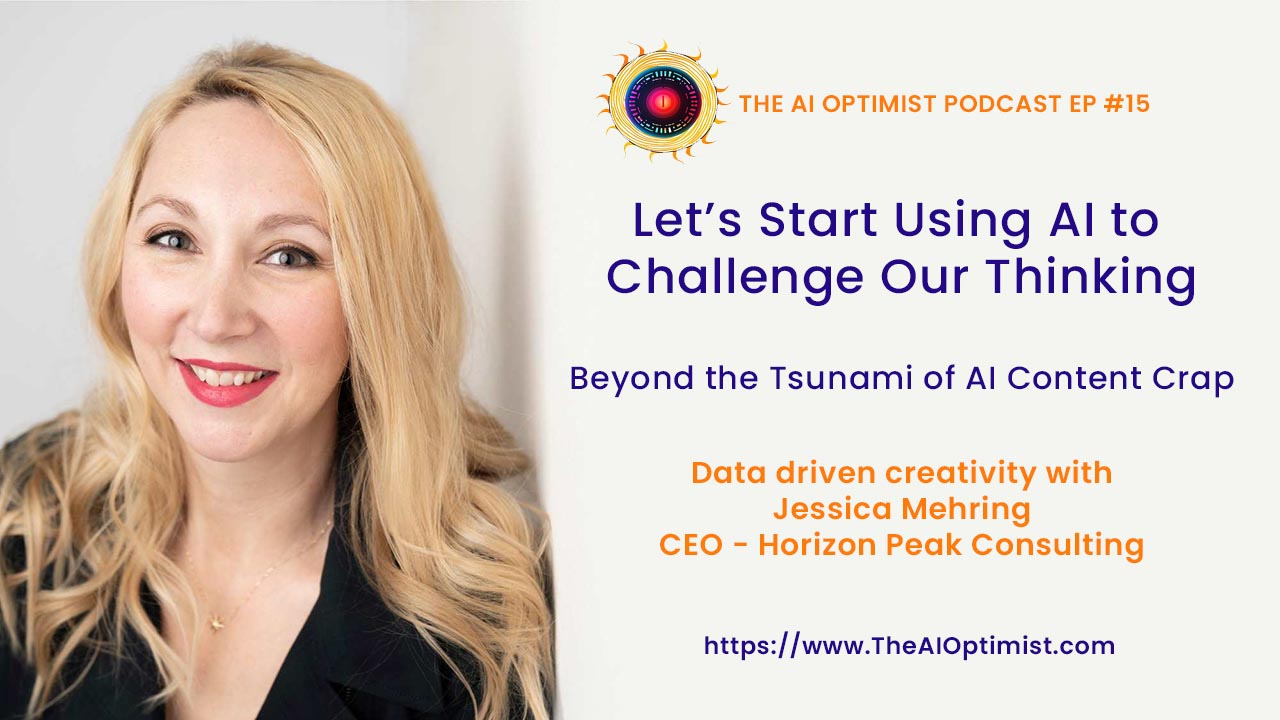Looking around at GenAI, many are adding to the tsunami of AI content crap. Because they are trying to let ChatGPT lead the way, and act like it’s a search engine!
Step into a mini-class with senior content conversion writer Jessica Mehring and Declan take you beyond the surface and into creating actionable content.
More than a pod, this is a mini-class in using data driven creativity. Follow the customer’s voice and learn how to use ChatGPT to upskill your content creation.
Now on YouTube, the AI Optimist video pod each week.
“One of the most powerful ways I’ve found to
use ChatGPT lately is to challenge my thinking.”
Jessica Mehring
The first wave of GenAI is bringing along a déjà vu of the Tsunami of Content Crap, people using AI to write content without checking it or bothering to improve the quality.
Of course, you can join the uproar or do something different. AI’s value is in sharing perspectives from different viewpoints and challenging you.
As JA Konrath wrote about the first tsunami of crap content reaction, the faux outrage of anyone being able to write a book:
“So instead, they cloak their fear and envy in a poorly constructed argument that says their real intent is protecting readers from crap.
Newsflash: there has always been crap and always will be crap. Get over it.”
With all the hype about ChatGPT creating content, how about using AI to challenge your thinking?
Jessica Mehring, CEO of Horizon Peak Consulting, chooses the challenge of creating excellent content in the face of the tsunami of crap.
She delved into researching why and how people use GenAI, sharing discoveries in this pod that point out a flawed approach that she’s helping to improve.
Jessica is a strategic consultant and senior conversion content writer. She began writing copy at a top creative agency and a top technology company.
She is relentless in improving her writing and communications consultant skills by keeping up with the trends and growing research behind successful content marketing.
As a writer, she sees the vast amounts of lousy content being created, from SEO clone articles to blog posts written solely by ChatGPT. She takes a different path, one we explore in this pod.
Podcast Summary:
I. Using AI to Challenge Thinking
II. Limitations of AI Content Creation
In addition, we’ve developed two action plans to follow what you learn in this pod. Included are prompts for each step, either using AI to challenge your work or using AI to create content.
III. Action Plan: Using AI to Improve Your Work
IV. Action Plan: Using AI to Create Content
V. Comparison of the Two Approaches
I. Using AI to Challenge Thinking
Jessica shares how she writes first and then uses ChatGPT to summarize, expand, or critique her work.
Writing first helps her identify blind spots and logical gaps to improve vocabulary/phrasing and find new angles she hadn’t considered.
Jessica uses AI to challenge her thought processes and improve her writing, not to replace writers who work with her company.
She uses it for analogies, creative words, and testing ideas.
The key is using AI as a “co-pilot” to augment your skills, not replace them. Please don’t rely on it solely for writing.
II. Limitations of AI Content Creation
Early search results and AI content show “language homogeny,” resulting in standardized, repetitive phrasing and ideas.
Language homogeny refers to the dominance of a single language within a community, often excluding other languages.
While language homogeny makes communication more accessible, it risks losing linguistic and cultural diversity.
Poor use of AI may create a generic language devoid of human creativity while helping those needing more writing skills to find new outlets for their voices.
AI cannot replicate the human experience, and nuanced opinions arise from lived experiences.
Jessica cites her research into what people think about ChatGPT, including the mistaken assumption that it is a search engine.
ChatGPT needs more credibility and a variety of choices than the current search currently provides. Instead, we get a prediction based on the prompt and the questions we ask.
It is essential to ask the right questions, find answers by probing ChatGPT, and push it beyond simple responses.
Understanding that ChatGPT may provide incorrect answers makes checking sources critical.
Many users don’t realize AI can “hallucinate” fake facts and data not based on truth or research.
Training data limitations: much of AI’s data is from the internet, social media, and outdated books. Sources like Reddit, Wikipedia, social platforms, and public domain content form the foundation of AI content.
While robust responses happen, imagine if AI could access the vast resources of human knowledge.
We explore examples of how AI fails to generate good responses for scientific research, which demands critical thinking and research that is not available because of copyright issues.
Access multiple perspectives by challenging ChatGPT; probe its answers as it challenges your thinking. Dig deeper, and don’t take the first few responses as final answers.
Prone to biases, current AI is a reflection of our society. Bias is possibly inherent in all languages, differing by culture and by accepted biases that modern society may not recognize.
Overreliance on AI content leads to “model collapse” - AI replicates itself without new diverse inputs.
Poor AI-generated content as the basis for creating more content leads to a breakdown, or collapse, of the model’s intelligence.
We must continue to generate new content to improve AI responses and not rely on it to do all the work.
Now, apply what you’ve learned in this podcast to your business. Choose one or both paths to see the best way ChatGPT and other LLMs (Claude, Bard, Poe, et al.) can help you.
Creating content is one way, and it may help some elements of business. However, be cautious when creating content and relying on automation. Things get lost in the translation and automation of tasks that people would catch.
Be sure to audit everything you create.
Let’s start using AI to improve your work, as Jessica does.
III. Action Plan: Using AI to Improve Your Work
Write a draft of your article, story, and other content first.
Follow Jessica’s advice of “throat clearing”; your best ideas are usually a few paragraphs from the beginning.
She recommends deleting the first paragraph, where the brain clears ideas to find out what it wants to say.
Ask ChatGPT to summarize your draft and note if key points are missing. Be sure to prompt AI to provide constructive feedback. Ask it to bring up questions it has for what you’ve shared.
Prompt ChatGPT to suggest vocabulary or phrasing to express ideas clearly.
Encourage ChatGPT to brainstorm analogies, metaphors, and imagery to illustrate concepts creatively.
Use AI to expand sections demanding deeper details or explanations.
Suggest that AI create an alternative outline and compare.
Probe for constructive feedback on the overall tone, clarity, and impact.
Critically evaluate AI’s suggestions and incorporate ones that improve the work.
10 Prompts to Improve Your Content
Analyze my draft article about [topic]. Summarize the key points and point out where I missed anything important.
Suggest alternative vocabulary or phrasing to express this idea more clearly: [insert text]?
Propose ten creative analogies, metaphors, or imagery that illustrate this concept: [insert text]?
Recommend where more details are needed based on my draft. Should I expand on it with additional suggestions and specific steps to improve it? [insert text]
Reviewing the draft below, suggest a more robust outline structure and reorganize where needed. Provide explanations of why AI made changes and three suggestions for ways to improve it further.
Give constructive feedback on the overall tone and clarity of this content. Does anything feel unclear or ineffective?
Suggest ways to make an impactful conclusion based on the content.
Does the evidence back up my essential claims? What else strengthens my argument?
Which sections are the strongest in my draft so far and why? Which needs improvement?
What criticisms or counterarguments against my ideas would help improve my draft?
Often asking ChatGPT to provide Custom Instructions helps avoid asking the same questions each time; here are a few from Declan’s file:
- You are an expert on all subject matters
- Provide detailed explanations
- When reasoning, perform step-by-step thinking before you answer the question
- If you cite sources, ensure they exist and include URLs at the end
- Summarize critical takeaways at the end of detailed explanations
- Avoid 3+ sentence paragraphs.
- Provide analogies/metaphors to simplify ideas, concepts, and complex topics
- Write in an active voice
IV. Action Plan: Using AI to Create Content
Using ChatGPT to create content is a common approach. While this may help, especially for those who don’t naturally write, use Part III to check up on the content it creates.
Using these two together is a powerful way to get the best content.
Create a precise topic and outline for your article before involving AI.
Consider the best questions about your topic and weave them into a prompt (prompt suggestions below).
Give ChatGPT background context on the topic and intended audience. ChatGPT will fill in the blanks with context, and your response will be good. While some call this hallucinating, it’s more likely the result of a question without context.
Prompt ChatGPT to write a draft covering each section of your outline.
Ask it to go more in-depth for parts of your outline to increase the content and thought provided. The first response will often be average; ask more questions to get more precise details and improve the content.
Carefully review the AI draft, checking for factual inaccuracies. Even in doing this, remember to always check for sources AI shares.
Constantly audit your AI responses. Don’t trust it. Please search for the answers to make sure they exist. Often, there may be a related answer out there. The one provided is more of a placeholder for you in this case.
Edit the draft extensively to add your voice, perspective, and examples. Ai doesn’t have empathy or personal experience; add this to make the article more engaging.
Perform additional research to expand on key points and back up claims.
Rewrite entire sections in your own words if the AI phrasing feels off.
Use AI to rephrase small sections or suggest new supporting points.
Ten prompts for Using AI to Create content
Create an article about [topic] for [audience]. Create a draft covering each section of this outline.
Here is some background context about [topic] for creating the content. Include relevant facts and data points related to this background.
For the section about [key point], expand on it with vivid examples and supporting evidence to illustrate the concept clearly.
Review the draft created carefully. Does it contain any factual inaccuracies? Please revise any questionable data and suggest where weaknesses in the response demand further research.
Rewrite the first draft, which is formulaic. Rephrase the section on [topic] to be more lively and conversational.
The section about [topic] must include original research to support the claims per my outline. Add 3-4 new data sources.
The first draft feels bland and impersonal. Analyze the following (cut/paste the content after this prompt) content and rewrite sections in a similar voice and style.
Rephrase this paragraph more concisely. (refer to the content from an outline title or cut/paste the content after the prompt).
What additional supporting points or examples of [topic] strengthen this section?
Does the draft persuade the intended audience? What else increases its impact? Provide suggestions along with five questions to improve the quality of the draft.
V. Comparison of the Two Approaches
Writing your content and having ChatGPT edit and improve it is recommended.
Beginning with a human voice allows AI to shape your writing.
If you start with ChatGPT to create content, the responses are less likely to sound like a human-made them. Humanizing the voice is crucial in moving content from machine-generated to sounding more like you.
A unique voice is what sets your content apart. Good prompting can help AI deliver better responses.
Also, look for alternatives to ChatGPT, like Claude and Bard. Compare results between them to find out how to deliver unique content that saves you time.
Using AI to challenge your thinking results in original, nuanced content that retains your unique voice.
Keep a copy of your best content to train AI in the style and voice you like to use.
Ask it to analyze and write content in that voice by cutting/pasting the content, asking AI to explore it, and then follow up with the content you want rewritten in that voice.
Asking AI to write first drafts leads to formulaic, homogenized content needing more personality. It requires extensive editing, which takes almost as much time as writing.
Be sure to use AI to challenge your thinking; combine these two approaches if you are generating content first with AI. It may take a little extra time, but the results will improve.
Use the challenge AI approach to improve your skills.
Creating content first with AI risks replacing your unique input with a generic response. Constantly improve what you get when using AI to generate content first.
The AI challenge method builds critical thinking. As a co-pilot, AI will provide insights into your actions with angles you might not have considered.
AI first puts all your eggs in one automated basket. Don’t expect great content, and run it through anti-plagiarizing software. Grammarly is also good at improving content like this to make it sound more human.
The challenge approach develops writing over time by incorporating AI feedback.
The AI content approach risks stagnating skills and relying on answers similar to what others create.
Since you wrote the core ideas, the challenge route is less risky for misinformation.
Use a blended approach for best results: write a draft first, then get AI feedback to improve it.
Human touch enhances the power of machine intelligence.


















